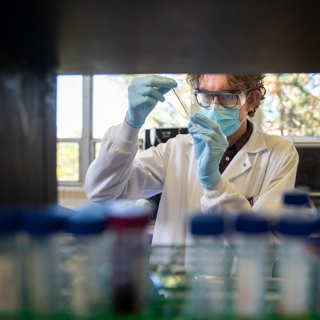People
Monica Serban
Professor
Contact
- Office
- 394 Skaggs Building
- Phone
- 406-243-4907
- monica.serban@umontana.edu
- Website
- http://health.umt.edu/biomed/labs/serbanlab
Personal Summary
Dr. Monica Serban received her PhD in Medicinal Chemistry in 2007 from University of Utah, under the mentorship of Dr. Glenn Prestwich. During that time, she was part of the Center for Therapeutic Biomaterials, where her work was focused on syntheses and characterization of novel hyaluronic acid (HA)-based biomaterials with therapeutic applications. In fall 2007, she joined Dr. David Kaplan’s laboratory at Tufts University as a Ruth L. Kirschstein postdoctoral fellow. During her tenure at Tufts, her projects were focused on the development novel silk based biomaterials. In 2010, she took her first industry position with Tengion, a development-stage regenerative medicine company, where her biomaterials expertise was leveraged for the development of novel scaffold systems for the injectable delivery of autologous cells into diseased organs. In 2011, Dr. Serban joined Allergan Medical’s Product Development team, where her role was focused on driving medical device innovation, intellectual portfolio enhancement, and new technology design and development. Prior to joining the University of Montana, Dr. Serban was a lecturer at Tufts University.
Education
Ph.D. Medicinal Chemistry, University of Utah (Salt Lake City, UT), May 2007
M.S. Organic Chemistry, Babes-Bolyai University (Cluj-Napoca, Romania), May 2001
B.S. Chemistry and Physics, Babes-Bolyai University (Cluj-Napoca, Romania), May 2000
Courses Taught
Advanced Materials Characterization I (MTSI 551) - The course provides an overview of fundamental principles of analytical, biological and mechanical material characterization techniques in the context of academic and industrial research, complemented with particular emphasis on most commonly used instruments and methods. Students will be familiarized with the most common material characterization instruments and techniques from both academic and industrial settings, and will improve their critical thinking, experimental design and communication abilities through the class project and assignments.
Medical Devices (BMED 595/PHAR 491) - The course focuses on the medical device product development process with particular emphasis on implantable devices. Research, regulatory, manufacturing and commercialization hurdles associated with translating a concept into a commercialized product are discussed. Students will learn to employ the fundamental principles of materials and biological systems for product development, identify the regulatory agencies and regulations associated with the commercialization of a device, understand and describe the medical device product development process , conduct risk management activities and identify device failure modes.
Research Interests
Reversible, thixotropic 3D cell culture systems
Slow-release antibacterial system for otic therapeutics
Silk-based tissue sealant for seroma prevention
Silk-fibroin based wound healing devices
Biomaterial-based therapeutics for cytomegalovirus induced hearing loss
Sustainable, glucaric acid-based material systems for controlled release applications
Publications
RECENT PATENTS AND PATENT APPLICATIONS
- M.A. Serban, The in vitro evaluation of an antibiotic controlled release system for the development of single-application otitis externa therapeutics – US 62/462,198 (University of Montana)
- M.A. Serban, S. E. Burke, W. A. Daunch, V. Patel, B. Jones, S. Limem, J. L. Akers, K. N. Patel – Implantable medical devices – PCT/US2014/052264 and WO/2015/027144 (Allergan Medical)
- M.A. Serban, S. E. Burke, W. A. Daunch, V. Patel, B. Jones – Medical device with anti-adhesive property – PCT/US 2015/0057685 (Allergan Medical)
- M.A. Serban – Silk medical devices – PCT/US 2015/0056261 (Allergan Medical)
- E. Pavlovic, M.A. Serban, X. Yu, N. J. Manesis - Crosslinked silk-hyaluronic acid compositions – PCT/US 2014/0315828 and WO/2014/17158 (Allergan Medical)
- J. Basu, R. Payne, N. F. Robbins, D. Jain, C. R. Halberstadt, M. A. Serban – Injectable formulations for organ augmentation - WO/2012/064369 (Tengion)
RECENT PUBLICATIONS
- B. A. Serban, K. T. Stipe, J. B. Alverson, N. D. Priestley, M. A. Serban, 2017, The in vitro evaluation of a controlled antibiotic release system for the development of single-application otitis externa therapeutics, Gels, 3(2):19 - featured article
- E.J. Johnston, T. N. Smith, M.A. Serban, 2017, Nanoparticulate poly(glucaramide)-based hydrogels for controlled release applications, Gels, 3(2):17
- Serban MA. Translational biomaterials-the journey from the bench to the market-think 'product'. Curr Opin Biotechnol. 2016 Feb 26;40:31-34

- Serban MA, Knight T, Payne RG, Basu J, Rivera EA, Robbins N, McCoy D, Halberstadt C, Jain D, Bertram TA. Cross-linked gelatin microspheres with continuously tunable degradation profiles for renal tissue regeneration. Biotechnol Appl Biochem. 2014 Mar-Apr;61(2):75-81. Related citation
- Serban MA, Knight TA, Payne RG. Preparation and evaluation of natural scaffold materials for kidney regenerative applications.Methods Mol Biol. 2013;1001:133-43. Related citations
Affiliations
Adjunct Professor, Department of Chemistry and Biochemistry
Professional Experience
Lecturer, Tufts University, Biomedical Engineering Department, January 2015 – May 2015
Senior Scientist, Medical Device Product Development Group, Allergan Medical (Medford, MA), July 2011 – November 2014
Scientist, Biomaterials Research & Development Group, Tengion (Winston-Salem, NC), July 2010 - July 2011
Postdoctoral Associate, Department of Biomedical Engineering, Tufts University (Medford, MA), November 2007 - June 2010

